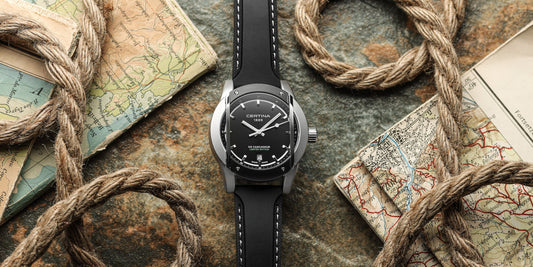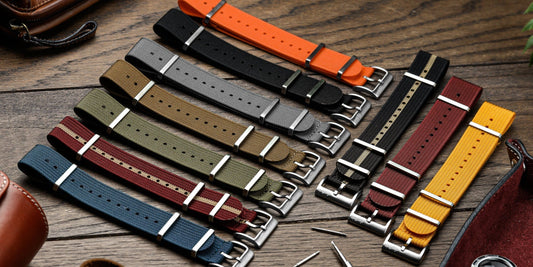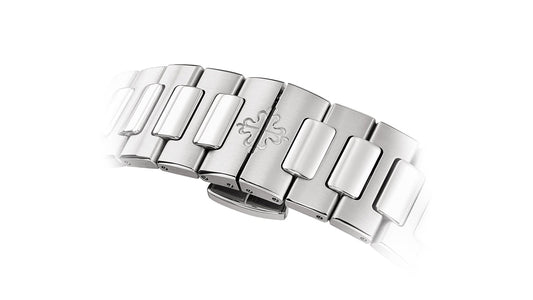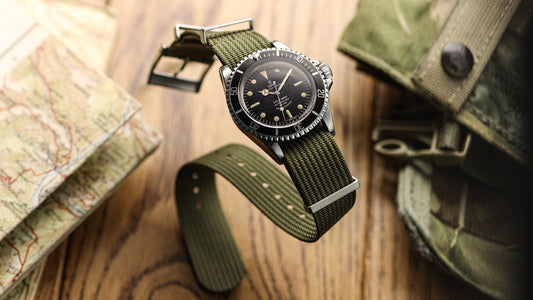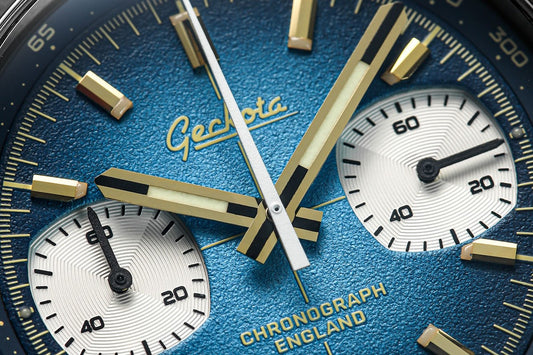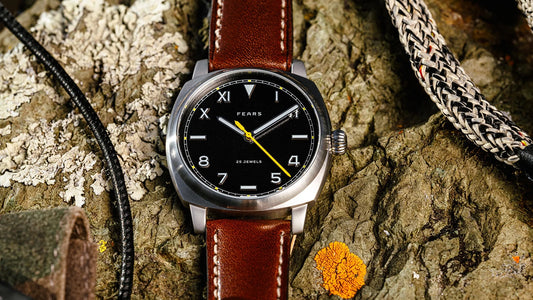There have been some vintage seiko watches over the years, do you know the history behind the iconic brand? Read on to find out...
So where to start? This won’t be the first look at Seiko icons or the last. In 2014, Mark Barnardo wrote a great piece, ‘The History of Seiko Through 12 Milestone Seiko Watches’ for WatchTime. Unsurprisingly, I’ll mention several timepieces that he described. Not to do so would be like writing that Toyota article without mentioning the two Toyota 2000 convertibles made specially for 1967’s James Bond movie, You Only Live Twice. Or leaving out the breathtakingly fast, road-hugging Celica GT-Four from the 1980s…. Forgive me as I digress into James Stacey Nuvo magazine territory…
So which Seikos to feature? Where else to start but with Seiko’s first wristwatch from 1924. It’s the original Seiko with its understated Seiko leather strap, clean white face and distinctive numerals. According to Geckota brand ambassador, Michael Langley of the Uchi Horology Series, it’s ‘a Didone display typeface with a little art-deco and high contrast thick stems and narrow serifs’. Michael’s a trained typographer, in case you didn’t realise….
Then there’s 1956’s Seiko Marvel (with the Seikosha manufacture’s first fully in-house movement). That’s before jumping forward a decade to honour Japan’s first chronograph watch, the Seiko Crown – originally supplied on a typically1960s Seiko bracelet.

The Seiko Marvel 1956 - Image courtesy of Seiko UK www.seikowatches.com/uk-en
Several Seiko world firsts
Later, we’ll remember how, in 1969, Seiko beat Zenith, Breitling and Heuer to market with the world’s first automatic chronograph watch (the Seiko 5 Sports Speed Timer, again on a Seiko stainless steel bracelet). And of course, along the way, there’s Japan’s first serious divers’ watch. Of course, it’s the 62MAS, a timepiece that precedes generations of classic, affordable Seiko dive watches on their distinctive rubber and stainless steel straps. Among them is the ubiquitous Seiko SKX007. This is arguably still the best value watch under £200 ($270)… Maybe even under $1,000.
Then there’s 1969’s Seiko Quartz Astron. Paradoxically, given the later cheap ubiquity of quartz watches, this launched with a luxurious 18k gold case on a stylish Seiko leather watch strap. For many commentators, it’s the watch that triggered the quartz crisis that devastated Swiss watchmaking for two decades – and precipitated its transformation forever.
The Seiko Spring Drive Watch - Image courtesy of Seiko UK www.seikowatches.com/uk-en
Seiko goes kinetic
A decade later the AGS ‘Kinetic’ looked striking in two-tone steel and gold, on Seiko’s matching two-tone stainless steel bracelet. It was the forerunner of modern kinetic and solar-powered timepieces. Thereafter, Seiko’s AGS (Automatic Generating System) was progressively refined until, in 1998, the Seiko Kinetic Chronograph was launched. This is one of Seiko’s few (but very distinctive) automotive-inspired watches. And on the subject of evolving technology, let’s not forget 2008’s Seiko Spring Drive ‘Spacewalk’.
Vintage Seikos and replacement straps
Purists will maintain that anyone fortunate enough to own these Seiko classics on genuine Seiko watch bands should think carefully before fitting modern replacement straps. If you decide to do so, make sure to keep the original safely – selling is always easier and more financially rewarding with a genuine vintage Seiko bracelet or strap included!
Are you seeking modern replacement watch bands for Seiko watches with vintage or antique status? Those are watches over 30 years or 100 years respectively, according to Thomas M. Meine and Matthew Stannard in Collecting (Vintage) Watches and you’ll need to be very choosy about your replacement strap or bracelet choice. Fortunately, matching Seiko replacement bands to more recent Seiko watches is much easier and likely to have much less impact on value. As we’ll see later, it will probably enhance your Seiko too...
The Seiko SNA 411 Pilot's Chronograph

As I throw a few more recent – and affordable – Seiko classics into the mix, we’ll touch on their pilots’ chronographs too. These include the well-featured (but hugely impractical, due to its size and minute dial print) SNA411 pilot chronograph. This watch is sometimes called the ‘poor man’s Navitimer’ or (erroneously) the Seiko SNA411 ‘Flightmaster’.
Among current Seikos, the Flightmaster is actually a different Cal. 7T92 quartz chronograph with slide rule bezel. If the ex-works stainless steel bracelet isn’t to your liking, it’s easy to change the original bracelet for a Seiko Flightmaster leather strap from an independent strap supplier.
Today’s Flightmaster is nothing like the AGS ‘kinetic’ Flightmaster SBCW005 that Seiko developed with long-haul pilots in the 1990s. Unlike the current incarnation, this classic aviation watch featured a dual-time GMT movement. The modern Flightmaster and SNA411’s, anachronistic ‘Navitimer-style’ circular slide rules may be cool. But you’ll probably agree that GMT and dual time is more useful for day-to-day use. The original Flightmaster, on a stainless steel Seiko Flightmaster strap, was the aviation member of Seiko’s ‘master’ line-up. This included pilot watches, Landmaster field watches, and the seriously ahead-of-its-time Scuba Master SBBK002. This multi-function diver’s watch had mind-blowing dive-computing capability way before affordable wrist-worn dive computers became the norm.
Seiko watches dress up
Of course, Seiko’s range has always included some gorgeous dress watches and Haute Horlogerie pieces. I’d be guilty of serious dereliction of duty if I omitted Seiko’s original Cocktail Time watches. These include the SARB065 (‘cool’), SARB066 (‘dry’) and SARB067 (‘sweet’) designed with famous Japanese cocktail maker Ishigaki Shinobu. Later came the ASARY075 and SRPB43J1 and most recently, 2018’s Presage SSA343J1 automatic with centre power reserve. They’re all affordable gems that come on either a stainless steel Seiko bracelet or black leather watch straps with contrasting stitching. If you can find one of the now discontinued originals, grab it; many rate this Seiko as the best ‘sub-$1000’ dress watch money can buy!
While we’re discussing dressy timepieces, what could be classier, more expensive, or rarer than 2016’s Seiko Credor FOGAKU Limited Edition? And back with eminently affordable Seikos, two of my favourites bridge the gap between dress and field watches. They’re the SARB017 Alpinist and SARG005. But as we’ll see, you’ll probably want to replace the factory-supplied Seiko watch bands...
So there we have a century of Seiko watches in a nutshell. Or perhaps, more appropriately, in a handcrafted, Zaratzu-finished, watch case. That’s my introductory snapshot of watches that capture the brand’s essence since ‘Seiko’ first appeared on a wristwatch dial. Now let’s explore further…
What started it all - Image courtesy of Seiko UK www.seikowatches.com/uk-en
It all began in Seikosha
This isn’t the place for more than a brief history of the company founded by Kintarō Hattori in 1881 and now called Seiko. Others have documented Seiko history much better – not least John Goodall in A Journey in Time – The Remarkable History of Seiko. And of course, Seiko’s Museum in Tokyo is a great source of information – whether online or as a must-visit destination in Tokyo. Suffice to say that, in 1881, aged 22, the ambitious Mr Hattori opened his watch and jewellery shop in Tokyo. In 1886, he moved to the city’s stylish Ginza. His company was on its way to becoming the world’s biggest clock and watch producer.
Japan’s first home-grown wristwatch
In 1892, he established Seikosha (which translates roughly from Japanese as ‘House of Exquisite Workmanship’) as his clock-making arm. The company’s first pocket watch, the Seikosha Timekeeper, appeared in 1895. In 1913, came Japan’s first home-grown wristwatch, the 12-ligne movement Laurel. Just over a century later, the Laurel’s significance was formally recognised. In 2014, the Japan Society of Mechanical Engineers (JSME) certified the wristwatch, originally launched on a simple Seiko leather band, as a ‘Mechanical Engineering Heritage’. This celebrated the Laurel’s contribution to the development of machines in Japan. It wasn’t until 1924, with Japan’s Taishō period waning, that ‘Seiko’ (demonstrating Hattori’s far-sighted confidence in using a Japanese name) first appeared on watches. It’s is an abbreviated form of Seikosha (translating into ‘exquisite’ or ‘success’). How prophetic history has proved the name to be…
The 1956 Seiko Marvel
The Seiko Marvel 1956 - Image courtesy of Seiko UK www.seikowatches.com/uk-en
The word ‘iconic’ is terribly overused. As editor of the Guardian style guide, David Marsh described the word as ‘stripped of all meaning by tedious repetition.’ However, over the years, many Seiko watches have earned genuinely iconic status. Among them is the 1956 Seiko Marvel (originally supplied on a complimentary brown leather alligator strap). This was the first Seiko-branded watch manufactured entirely in-house and it came first place in a 1957 competition by the Japanese branch of the American Watchmakers-Clockmakers Institute. With this recognition, Seiko dispelled perceptions of ‘cheap Japanese timepieces’ forever. The Tokyo-based brand was on a roll and the world was taking notice…
Seiko Crown Chronograph (1964)
Seiko Crown Chronograph- Image courtesy of Seiko UK www.seikowatches.com/uk-en
In October 1964, the eyes of the world were on Seiko’s home city of Tokyo when it hosted the Olympic Games. Seiko was official timekeeper as Britain’s Ann Packer was a surprise 800 metres winner and Joe Frazier, a future world heavyweight champion, won boxing gold.
That year, Seiko celebrated the launch of Japan’s first homemade chronograph watch. It was the mono-pusher Seiko Crown Chronograph with smooth-operating, durable, central column wheel. Arguably, this watch, on its stylish steel bracelet, remains Seiko’s most significant chronograph. For this alone it deserves mention.
A year later came the first of the dive watches that, for many Seiko fans, still define the brand… Seiko was going swimming…
Seiko goes swimming
As the Seiko Marvel was launched, divers’ watches were gaining popularity on the back of post-war interest in recreational scuba diving. Only a few years earlier, diving was pretty much restricted to military specialists. However, during the 1950s, the Aqua-Lung breathing equipment invented by Émile Gagnan and Jacques Cousteau became more accessible, and underwater filming by Cousteau, and Hans and Lotte Haas provided inspiration.
A new generation of sports dive watches such as the Rolex Submariner, Blancpain 50 Fathoms and Zodiac Seawolf became must-have diving accessories. With Japan’s strong maritime association and the company’s global aspirations, it wouldn’t be long before Seiko launched its own answer to divers’ needs… In 1965, Seiko introduced what’s widely regarded as one of the most important divers’ watches ever – especially among relatively affordable divers. History shows that the Seiko 150 m divers’ watch set the tone – and defined the design language – for generations of dive watches. As Seiko’s first pro-dive watch, it predates favourites such as the SKX series, Samurai SBD400X and 6309-7040 on Seiko’s GL831 rubber strap.
Seiko Diver’s 150 m (1965)
The Seiko Diver 150m - Image courtesy of Seiko UK www.seikowatches.com/uk-en
Thus, the Seiko Diver’s 150 m watch, the 6217-8000/1 or 62MAS-010 (from ’62 Model AutoMAtic Selfdater’) entered dive watch vocabulary. It was the first professional-level, dedicated dive watch made in Japan. As such, it was destined to be a timeless classic on one of the most distinctively textured Seiko divers watch straps – what some now call ‘Clouds de Paris’, Diamond or – less romantically – ‘hobnail’ design. You need only read John Goodall’s excellent A Journey in Time – The remarkable History of Seiko, to appreciate how closely Seiko has always worked with professional users, including divers. It’s been one of the keys to ensuring that its sports watches can survive the toughest environments while giving wearers potentially lifesaving information.
To quote Goodall: 'Seiko launched Japan’s first divers watch, the Seiko 150M Diver, in 1965. At that time relatively few people were involved with diving, so this was a very specialised product. Then, even in Switzerland, very few timepieces were described as diver’s watches… Even today, some manufacturers respond to the allure of the market for diver’s watches by labelling almost any water resistant watch as a diver’s watch, but Seiko takes its responsibilities more seriously.’
2017 Seiko 62Mas Re-Edition
Seiko Prospex Diver SLA017 1965 Re-Issue - Image credit Monochrome Watches: monochrome-watches.com
Based on this approach, the 62MAs set the course for generations of ‘divers’. All were capable of withstanding increasingly deep immersion. No surprise then, that at Baselworld 2017, Seiko revealed a re-issue of the watch that started it all.
This was the Seiko 62Mas Re-edition SLA017 Prospex. It came complete with the revered details of the original, right down to the same style Seiko rubber strap with its distinctive texturing… When examining the ‘New Old’ Seiko Mas62 at Baselworld 2017, I could have been back in 1965…
Seiko’s pursuit of excellence
Seiko’s obsessive pursuit of excellence is demonstrated by the seven-year hiatus in dive watch development after receiving a Japanese commercial diver’s letter. He highlighted the crystal damage that sometimes occurred to dive watches when ascending from saturation (SAT) diving beyond 300 metres. And while he had Seiko’s ear, he pointed out problems caused by impacts when working on the seabed…
Seiko immediately formed a new development team and sent its engineers and designers back to their drawing boards. The result was the titanium-cased Seiko Professional Diver’s 600M watch (1975) – the now-legendary Seiko 6159-7010 Hi Beat Tuna on its stainless steel bracelet or rubber Seiko divers watch band. Since then, Seiko has unceasingly met the needs of amateur and professional divers by combining performance and value in ways that few dive-watch makers – at any price point – can match.
Many divers turned to Seiko
Sure, many newly wealthy commercial divers, such as those working in the North Sea oil and gas industry, bought Rolex Submariners and similar luxury watches to go with the obligatory Porsche. However, many divers seeking tough, ISO 6425 compliant, general-purpose dive watches, or pro divers wanting serious performance for a fraction of ‘Sub’ prices chose Seiko. In particular, watches such as the now-classic quartz-powered Seiko SBBN015 Seiko ‘Tuna’. Or more recently, the Prospex (‘Professional Specification’) SEA Marinemaster Spring Drive Professional SBDB011. And, of course, for general purpose diving and as versatile everyday wear, the ubiquitous Seiko SKX series…

Since 1965, these divers’ watches have demonstrated the extent of Seiko’s commitment to those venturing into the water. It’s the same commitment whether the watch will be worn for SAT diving at 300m, holiday snorkelling on Kos or while vicariously living the diving dream as ‘desk divers’…
Alongside the watches, the distinctive expanding rubber Seiko strap design has itself become iconic. Since being introduced decades ago, its concertina design has been embraced by many other manufacturers for its practicality and ability to accommodate changing pressures at depth – if not for its ultimate comfort. This is another reason why wearers of Seiko tool watches often look to third-party strap suppliers for alternatives.
You or I could easily put a dozen Seiko divers in this hall of fame. However, given the constraints upon me, and the fact I’ve already mentioned the original 62MAs, I’ll stick with the classic SKX series. In particular, the SKX007, a watch that so many real (and ‘desk’) divers, have loved for its style, reliability and value.
The definitive accessible Seiko
As I write, I can buy a brand new SKX007 on an expanding resin strap for under £200 ($266). What a bargain. No wonder the SKX is often cited as the best general purpose watch you can buy under £500 ($664). So, for being Everyman’s knockabout, water sports, diving and general purpose tool watch, it’s Seiko’s 7S26-powered SKX007, the poster-child for Seiko ‘beater’ watches, that gets my vote as the definitive accessible Seiko...

To sum up, I’ll quote Monochrome writer Ilias Giannopoulos as he begins his 2014 tribute to the SKX:
‘In this article, we will not examine a rare chronograph, a long-forgotten military watch, a historic aviation piece, nor any vintage timepiece that will make a record sale at Bonhams. We will not argue about exquisite calibers, or exotic methods of construction. Nor will we analyze avant-garde design. Instead, let’s focus on a type of watch that every person who loves watches absolutely must have. The beater watch, a Seiko SKX007.'
At this point, I’ll surely draw comments from readers like a shoal of hungry sharks converging on a dive site. From Seiko fans who consider other Seiko divers worthy of mention as well as (or instead of) those I’ve chosen. No problem! Bring on your suggestions (and their justification) in the Comments section. I’m watching from the safety of the dive boat!
The first auto-chronograph to market
As the clatter of keyboards intensifies, we move to my next Seiko Hall of Fame entry, 1969’s Seiko 5 Sports Speed Timer (Cal. 6139). And, of course, to that year’s race to get the first automatic chronograph to market…
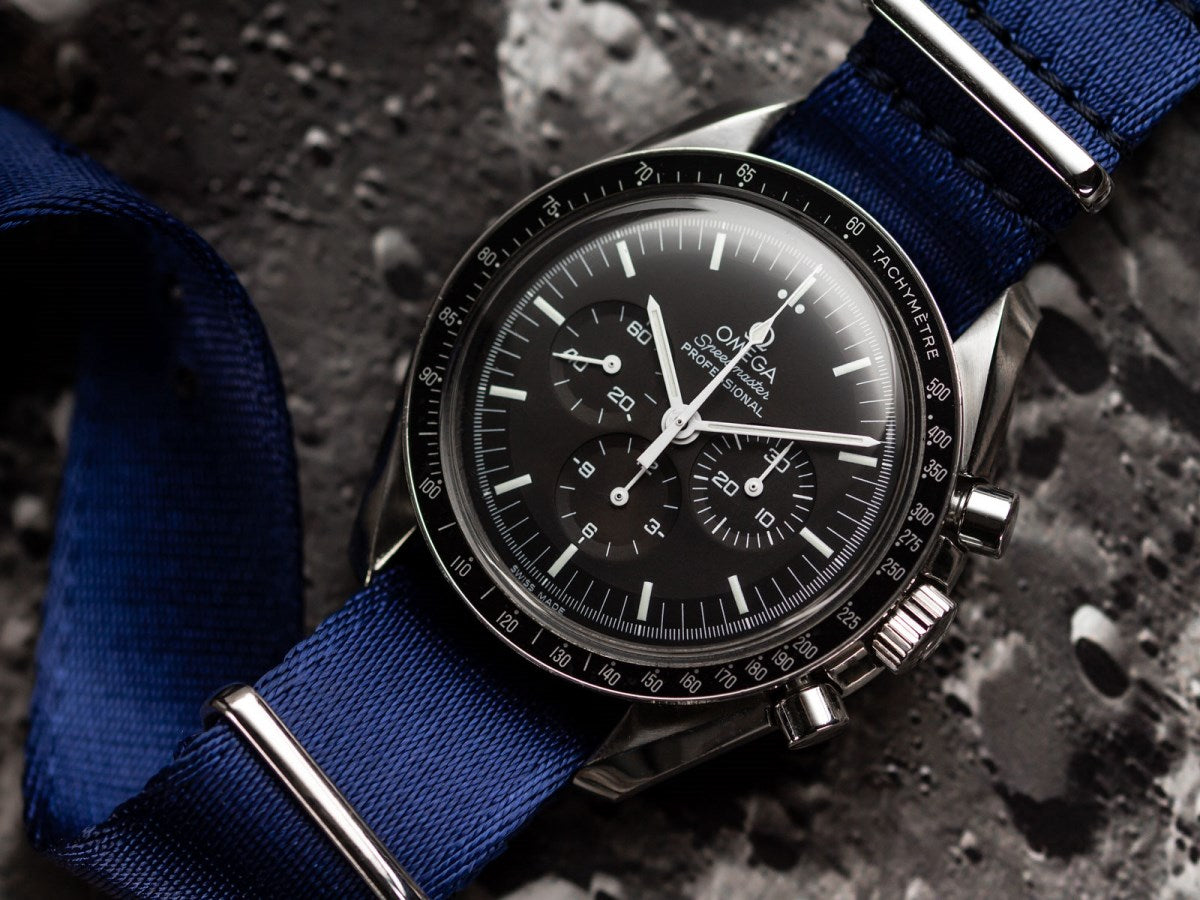
The high profile contenders were Breitling’s Chrono-Matic, Zenith’s El Primero and Heuer’s Monaco Ref. 1133b. However, according to Mark Bernardo, it was actually the blue and stainless steel Seiko with its vertical clutch and centre column wheel chronograph that got to market first. That was in May 1969, the month of Apollo 10’s dress rehearsal for July’s moon landing. And we all know how that, in the form of Omega’s hand-wound Speedmaster, delivered the most famous watch story ever!
The ‘Pogue’ Seiko
Interestingly, a later derivative of Seiko’s chronograph would also go into space. That was in 1973, when the yellow-dialled 6139-6002 ‘Pogue’ was worn (unofficially) on Colonel William Pogue’s left wrist during NASA’s Skylab 4 mission. So what was the official timepiece that he wore on his other arm? Of course, it was a NASA-issue Omega Speedmaster!
If you’re the proud owner of a Seiko Cal. 6139 watch on its original bracelet, you may not want to substitute a newer strap. But what if your watch band has been damaged or lost? Or if your Seiko 5 Sports is a more recent model? In either case, a new Seiko 5 leather strap or stainless steel bracelet could breathe new life into your favourite watch.
Seiko Quartz Astron
Seiko Quartz Astron - Image courtesy of Seiko UK www.seikowatches.com/uk-en
For Seiko – and the whole watch industry – 1969 was significant for more than just the Cal. 6139 automatic chronograph. With the Christmas launch of the innovative gold Quartz Astron on its dressy Seiko Astron leather strap, Seiko precipitated the quartz crisis that devastated Switzerland’s watch industry. With disclosure of the patent for the game-changing tuning fork quartz resonator and an open-type step motor, watchmakers around the world started to make super-accurate quartz-powered watches. The world of watches would never be the same…
No wonder a CNN Style article on the Seiko Quartz Astron rated the Astron, alongside Zenith’s El Primero, Rolex’s Submariner and the original Swatch, one of the world’s 10 most influential watches…
To quote CNN Style: ‘The Astron wasn't so much a cause of change as it was a manifestation of it – in Switzerland, a consortium of mechanical watch manufacturers had already made a quartz wristwatch prototype as well – but the Astron showed that it was possible to go from prototype to production for the first time, and goaded every watch brand in the world into realising just how rapidly their world was about to change.’ Besides, in 2014, the Japan Society of Mechanical Engineers (JSME) certified the watch as a Mechanical Engineering Heritage – just one of many awards given to the Seiko Astron.
Grand Seiko and Seiko Credor
Of course, history proves that Switzerland’s surviving watchmakers rallied with the reorganisations of the 1980s and Swatch’s astonishing success. And that the high-end Swiss brands reinvented themselves as luxury product makers rather than just watchmakers. Seiko has played an important role in this newly shaped horological world, not least with Grand Seiko (GS). And more recently, for supplying basic Cal. 1887 movements to TAG Heuer...
Grand Seiko SBGW252 Recreation of the First Grand Seiko Watch - Image credit Monochrome Watches: monochrome-watches.com
I digress; Grand Seiko, conceived as Seiko’s ‘ideal watch’, was designed to excel as it took on (and often beat) the best Swiss watch companies with its meticulous attention to detail and accuracy.
The first, from 1960, was the Grand Seiko with Caliber 3180 mechanical movement. This ground-breaking watch was certified to Seiko’s own accuracy standards, which exceeded the prevailing Swiss standards. To this day they remain more demanding than COSC certification. Back in the 1960s, this was the first Japanese watch to exceed the rating from the Bureaux Officiels de Contrôle de la Marche des Montres. It was sold with the corresponding rating certification. It also set the design codes and visual language that still define Grand Seiko.
Grand Seiko SBGW252 Recreation of the First Grand Seiko Watch - Image credit Monochrome Watches: monochrome-watches.com
If you’re fortunate enough to own one of these seminal Grand Seikos on one of the original Grand Seiko watch straps, it’s probably best to keep them together! If watch band replacement really does become necessary, and you can’t locate an original 1960s vintage strap, don’t skimp on your choice of Seiko leather strap replacement…
Mark Barnardo’s WatchTime article quite rightly references the 1969 Cal. 3180 for its historical and company significance. However, I’m going to invoke authorial privilege and include 1969’s Grand Seiko 61GS Very Fine Adjusted (VFA). This directly succeeded the original GS and was the first VFA Grand Seiko. I fell in love with the Grand Seiko 61GS VFA when I read about it, and admired the accompanying photograph, in Mark Cho’s chapter of Matt Hranek’s A Man and His Watch. Take a look and see what I mean…
Seiko Credor FUGAKU Limited Edition Tourbillon

Seiko Credor FUGAKU Limited Edition Tourbillon - Image Credit Deployant deployant.com
That’s it for Grand Seiko now. As of 2017, it’s a brand in its own right, not just a Seiko sub-brand. But that’s another story… However, before considering some of Seiko’s affordable aviation timepieces, dress watches and field watches, I want to mention another Seiko that I’d love to have in my collection. Arguably, it’s the most exquisite of them all…
The Seiko Credor FUGAKU Limited Edition Tourbillon (2016) is my choice to represent Seiko’s Credor brand. Credor ((the name originates in the French for ‘crest of gold’ – or crête d’or) outshines even Grand Seiko for horological excellence. Another reason this particular watch deserves mention is that it was Seiko’s first ever tourbillon timepiece. Apparently, it was the result of one Seiko horologist’s secret project to buck the company’s 135-year eschewal of tourbillons. Only eight examples of this Baselworld 2016 show stealer were made – at 50 million Japanese Yen (at the time, nearly $500k).
When it was announced in 2016, Seiko claimed the tourbillon mechanism was the world’s smallest by volume. It’s an attribute consistent with the thin, elegant Credor design philosophy and was achieved by integrating the wheel and bridge, and using a unique pallet fork design. As well as the tourbillon, owners got a hand wound 21,600 vph, 22-jewel movement in an exquisite platinum, gold and sapphire-encrusted case. There’s Urushi lacquer work, Raden (mother of pearl) and sublime Yakogai inlay. Plus wonderful blued-steel hands too. And all to marry Seiko’s exquisite horology craftsmanship with a stunning interpretation of Hokusai’s Edo-period woodblock, the Great Wave off Kanagawa…
If you are one of the eight lucky owners of this watch, you won’t be planning to replace the blue crocodile leather strap with its three-fold Platinum 950 push-button clasp. In this case, even the nicest Seiko replacement bracelet or strap from a leading independent specialist is unlikely to hit that particular spot…
Seikos that have impressed me
When planning this article, I recognised that many experts are far better qualified than me to judge Seiko’s most significant watches. Then thought about the Seikos that had caught my attention while climbing my personal watch industry learning curve. Because much of my watch writing is for the affordable watch space, you won’t be surprised when I include several very affordable Seikos.
These include the SRPB43J1 Cocktail Time, SNA411 pilot chronograph and Seiko 5 SNZG15K1. And the sublime, but now discontinued, SARB017 Alpinist. And the ‘crème’ dial SARG005 ‘Alpinist-style’ field watch. None should break the bank. Yet each, in its way, epitomises everything that’s endeared Seiko to decades of wearers. I’d even suggest that treasured Seiko are more often passed to the next generation than Patek Philippes!
Credor and Grand Seiko may represent the pinnacle of Seiko’s luxury ambitions. But for most wearers, Seiko is defined by affordable, reliable, well-made watches, many of which are candidates for early bracelet or watch band replacement. That’s because, to be honest, Seiko stainless steel bracelets and, particularly, their leather watch straps, aren’t always that special.
Seiko’s standard watch straps and bracelets…
As a manufacturer, Seiko makes thousands of wonderful, high-quality, watch variations in numerous colour, dial, bezel and case variants – all remarkably affordable. And therein lies the 'problem' when it comes to straps and bracelets. They’re all supplied on watch bands ranging from leather and stainless steel to a fabric Seiko military strap.
If Seiko watches share a common denominator, alongside value, quality and reliability, it’s probably their adequate-rather-than-astounding standard straps and bracelets. Why Seiko does this remains a mystery to me. But in any case, wearers often seem to swap the factory strap for their preferred aftermarket strap. If you love affordable Seikos, alternative straps will almost certainly be on your want list. You could do worse than search Google for ‘Seiko watch bands for sale’, ‘vintage Seiko watch straps’ or ‘Seiko watch strap replacement’ – maybe qualified with a name and model number…
Help! Seiko replacement watch straps needed
Thinking about Seiko’s standard straps and bracelets (they’re not exactly bad, just underwhelming given the watches’ otherwise exceptional value and quality), prompts me to recall my own Seiko SARG005. When travelling in Japan, I bought a Japanese domestic market (JDM) SARG005 with cream dial and compass bezel. But what a disappointment the supplied Seiko band was when compared to the watch’s otherwise-superb quality.

Fortunately, lots of excellent, reasonably priced, aftermarket straps and bracelets are available to transform Seikos like mine. As I write, it looks great on Geckota’s Italian handmade leather strap. The difference between this and the standard strap is very noticeable. Other Geckota options for Seiko owners include rubber dive straps (‘Bonetto Cinturini meets ZULUDIVER style’), stainless steel bracelets and SKX007-specific metal bracelet ends. For the SKX007-0020, Geckota’s 2mm diameter Seiko watch band pins reportedly fit better than Seiko’s standard spring bars.
Almost anything is possible
For anyone seeking a Seiko replacement strap, as I was, the same applies to leather straps and stainless steel bracelets alike. Maybe, like me, you want to replace the standard strap on your SARB017 or SARG005. Or you want to give your SNA411 the luxuriously padded and stitched black leather ‘Breitling look’. Whatever your taste in Seiko watches and straps, almost anything's possible.
The fact that Seiko watches look good on so many different types of aftermarket straps just reflects their timeless design. The SKX007, for instance, looks amazing on anything from a rubber military style, to a chunky leather band or stainless steel bracelet with solid ends. It’s a good thing, but it makes choosing even harder – which is where a specialist strap supplier with a genuine passion for, and knowledge about, wearing watches with different straps can really help.
Grand Seiko Hi-Beat 36000 Calibre 9S 20th Anniversary SBGH267 - Image credit Monochrome Watches monochrome-watches.com
We’re approaching the end of this brief look at some of Seiko’s most significant watches. In summary, the brand’s dive watch pedigree is undisputed, as is the reputation of its Grand Seikos and Credors. But for most of us, our perception of Seiko is determined by its bombproof divers, quartz daily-wears and explorers’ watches. And aviation watches, such as the original Flightmaster, affordable SNA 411 or 2018’s Prospex Radio Sync Solar.
In pursuit of Seiko’s motorsport watch
Before we finish, there’s a space in the watch market that remains unmentioned – a sector more often associated with brands such as TAG Heuer, Chopard, Hanhart and Hublot.
Seiko’s contribution to automotive watches has been relatively minor. But when they have touched the racing watch space, the results have been interesting. Take, for instance, 1998’s distinctive Seiko Kinetic Chronograph. If ever a watch deserved a prize for looking like a miniature car dashboard, it’s this one. It was also the first self-winding quartz chronograph, powered by Seiko’s Caliber 9T82A. Once seen, this Seiko is hard to forget. Five recessed dials (minutes, seconds, tenths of seconds, hours and minutes with central seconds, and date) nestle in a distinctive space-age stainless steel case. They were clearly inspired by deeply recessed dashboard instruments. Contemporary advertising for the Seiko Sportura Kinetic Chronograph used strong motoring imagery. This included the similarly-recessed dashboard ‘clocks’ of a speeding convertible, to link the Sportura to sports driving.
From 1924’s ‘Seiko’ to Baselworld 2018
Seiko Prospex Turtle Save the Ocean - Image credit Monochrome Watches monochrome-watches.com
Our nostalgic journey has brought us full circle from 1924’s first Seiko-branded watch to the latest Mas62 re-issue and Prospex Save the Ocean SRPC93K1. Along the way, we’ve touched on the 1950s and 1960s classics, Seiko’s key role in the quartz age, and the ubiquitous SKX007 that so many of us have owned at some point. We can conclude with the latest Presage SPB067J1 automatic as it respectfully honours Seiko’s 1913 Laurel.
And finally, we can look forward to the future and speculate about how Seiko’s future classics will look…
A watch for everyone
Seiko has built worldwide success on offering watches for everyone. Sometimes the company is knocked by luxury watch fanatics. And in some collectors’ opinions, no Seiko will ever have the cachet of ‘Swiss Made’ luxury timepieces. Even Grand Seiko is sometimes criticised for its, dare I say austere, design.
Whether you love or hate Seiko, you can’t argue with the fact that it’s a significant brand. It’s a brand that brings quality, excellent timekeeping and rugged reliability to millions of adoring enthusiasts – despite some decidedly average standard straps and bracelets!
Enjoy your Seiko
Are you replacing the original strap or stainless steel bracelet on your 1970s Seiko chronograph? Perhaps you are changing the standard leather watch band on your Seiko Sports 5? Or maybe you want to put your Seiko diver on a leather strap? Whatever you choose, you’re participating in the amazing Seiko story that Kintarō Hattori began in 1881…
Enjoy your Seiko, whether it’s on its original strap or bracelet, or not. They’re amazing watches!
Looking to add a Seiko to your collection? You'll want to check out our range of hand-picked Seiko watches now available on WatchGecko.




















